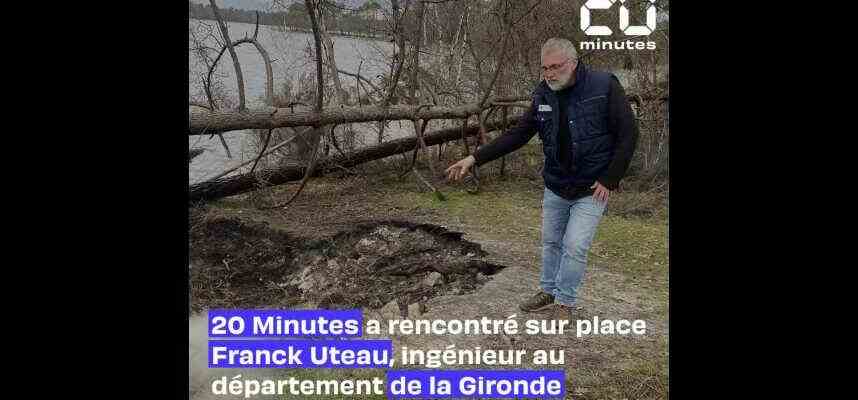Thick smoke escaping from a cracked ground on all sides, temperatures of 380 degrees in the basement, and an acrid smell that attacks the throat and quickly rises to the head… The scene is hardly believable. In the middle of winter, a fire is still smoldering, over several hundred meters, around Lake Bousquey in Hostens (Gironde). A direct extension of the Landiras fire in the summer of 2022, so… seven months ago. The fire which had ravaged 20,000 hectares of pine in July and August, had however been officially declared extinguished on September 28th.
“The fire has been extinguished, except for this area, which is known and well delimited around Lake Hostens” confirms the boss of the Gironde firefighters, Marc Vermeulen. “We are on an old mine of lignite [type de charbon utilisé pour générer de l’électricité], which was used to supply a power station in Hostens from 1932, and whose extraction stopped in 1960, explains Franck Uteau, engineer in the environment department of the Gironde department. There is still lignite in the ground, and thanks to a system of underground galleries, calls for air generated by a root network which is consumed, we have a fire which feeds itself with the wind, and as long as there is nothing to stop it, it will continue to burn. »
The authorities relied on the fall and winter precipitation to “drown” the terrain, but these were largely in deficit. “We thus find ourselves with a permanent fire” sums up Franck Uteau. Worrying, when we know that the “season” of fires in Gironde, usually restarts in the spring on the Landes de Gascogne massif.
Risks of falling trees and landslides
Could this underground fire start a new fire on the surface? That’s the big question. “Potentially yes,” says Franck Uteau, who indicates that a tree stump caught fire a few days ago, leading to the intervention of firefighters. “There is a risk that this situation will favor renewed fires in the spring, even if we are in an area that has already burned, so it would have little chance of spreading. »
That’s not all. “There is a real danger of burns if you get too close, a risk of falling trees, and the quality of the air is altered because we have heavy fuel that evaporates” enumerates Franck Uteau , which reminds us that the site is closed to the public, even if walkers do not hesitate to regularly defy this ban.
Landslides are another hazard, and could be fatal to the unwary if they make a bad fall. The engineer affirms that, since the beginning of winter, “the bank has already moved twenty centimeters in certain places”, measurements made possible by surveys carried out via a drone equipped with a lidar. Worse, these collapses could “uncover new homes buried deeper. »
Areas to be treated “too large” to consider “drowning” the field
What strategy to adopt in this situation? The question is debated. The mayor of Hostens recommends drowning this underground fire using pumps positioned in Lake Bousquey. A solution “difficult to envisage” for the president of the departmental council Jean-Luc Gleyze, especially in a context of drought and low water reserves. “The areas to be treated are too vast, the only way to drown this fire is to wait for a rise in the water tables, supports the departmental elected official. For the moment this is not the case, so we will treat the smoke locally and we will carefully monitor the situation, above all to prevent a fire from reaching an area that would have remained intact. »
“The situation is under surveillance, confirms the director of Sdis (Departmental Fire and Rescue Service), we regularly carry out flights using our drones to map the risks and see how it all evolves. We will see in the coming weeks, depending on the evolution of the weather, what additional measures we are going to put in place. »
“There is no extinguishing strategy for this type of fire, simply because there is no reference,” explains Franck Uteau. We have examples of coal mines that have been burning for decades, such as Centralia in the United States or at Jhara in India, but lignite fire does not exist elsewhere. Drowning this fire is an option, like others, but without any guarantee of success. After the fire started last week, the surrounding area was flooded by firefighters, and it’s smoking again today. »
An exceptional refuge of biodiversity two-thirds burnt
In the Bikini sector, along Lake Bousquey, the fire is smoldering over a 400-metre stretch, but it is not the only place in the Hostens area where smoke has been detected. “We also have some on the sector of the small lake of Bernadas on 300 meters of shore, and on the sector of the Demoiselles” points out Franck Uteau. It also remains to be seen how deep the fire goes. “We know that lignite was mined up to eight meters deep, in the area where Lake Bousquey is today. On the part where it burns, we are still at the limit of the deposit, so we hope that there is less thickness there. »
A monitoring project for the Hostens departmental domain after the fires has also been set up. “We carry out a thermal mission every month, we have a photo observatory mission, to compare the site before and after the fire, and we carry out aerial photography to make an ecological inventory of the site” explains further the engineer.
An exceptional refuge of biodiversity in the middle of the Landes de Gascogne forest, the departmental domain of Hostens, which hosts a leisure center on 750 hectares and the largest sensitive natural area in the Gironde, was two-thirds burnt after two Landiras fires. The nature reserve part should remain closed for several more months.

